Standard Models
Oliver Nos. 1, 2, 3, 5, 7, 9, and 11 were the standard models produced and primarily sold in the United States, with limited quantities sold internationally. In addition, the Oliver No. 15 was manufactured by British Oliver for sale in England. Other downstrike Oliver models, including the 32-key export models, are derivatives of the standard models, most of which were marketed outside of the United States.
Oliver No. 1
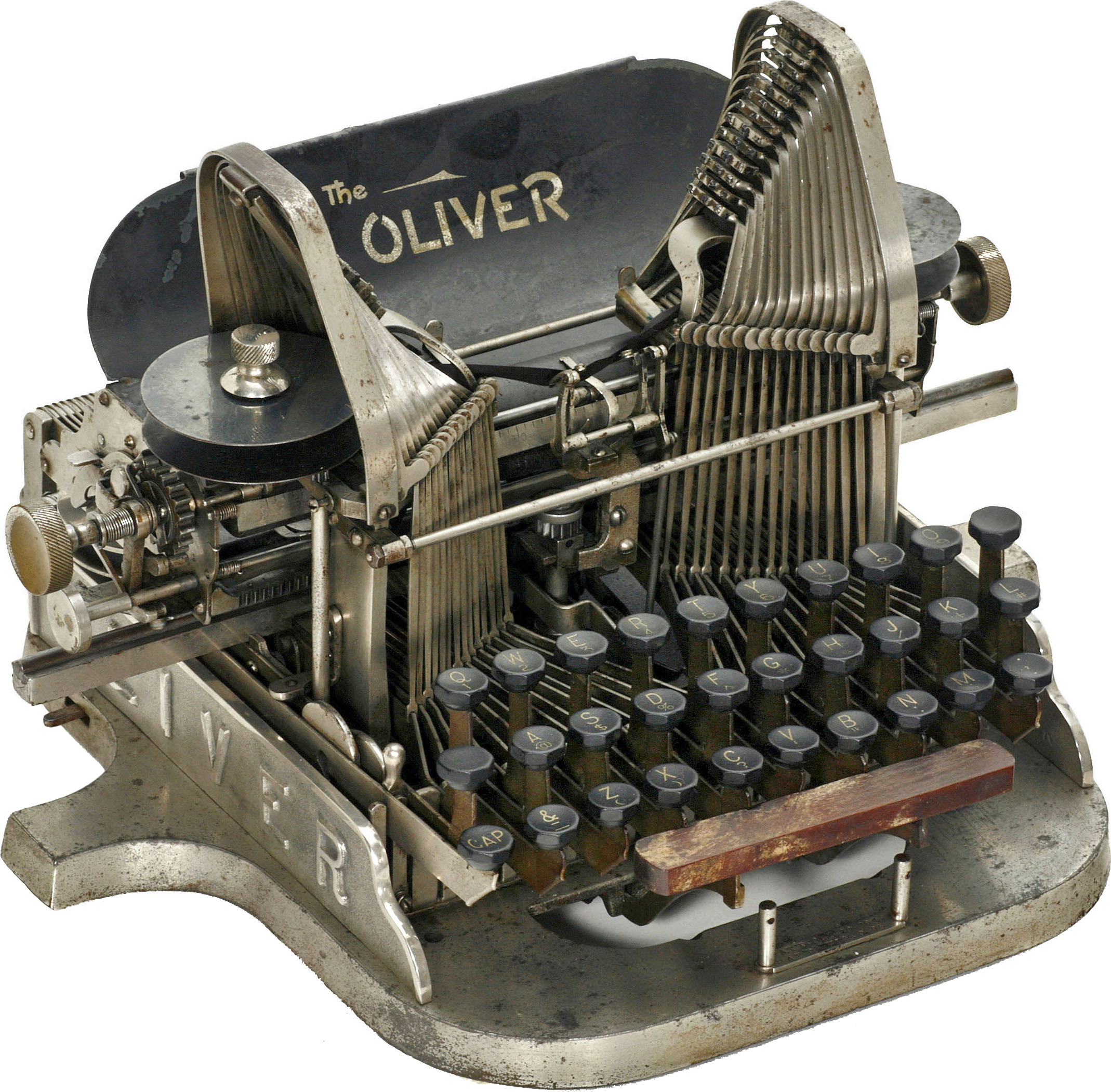 Oliver No. 1
Oliver No. 1
Courtesy Auction Team Breker
www.breker.com
The Oliver No. 1 is distinguishable from later models by its flat side handles and unique side panels. They were nickel-plated and have a black paper table. The rod connecting the type towers was introduced during Oliver No. 1 production. Earlier machines have metal key combs while later machines often have composite key combs. Eventually, a paper table decal was added and the letters and figures on the key tops were swapped.
Oliver No. 2
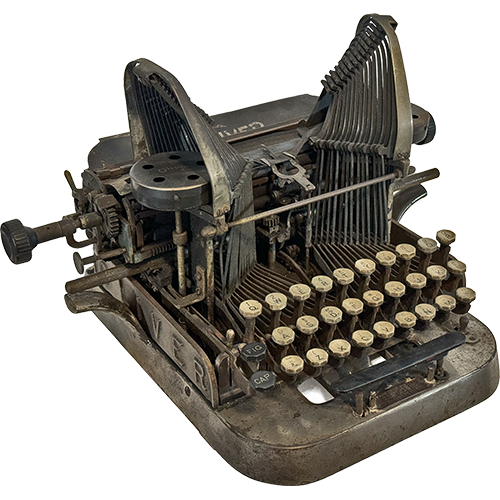 Remodelled Oliver No. 2
Remodelled Oliver No. 2
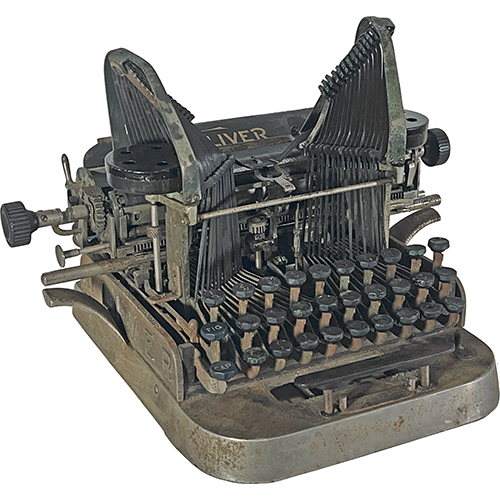 Oliver No. 2 with black
Oliver No. 2 with black
character and shift keys
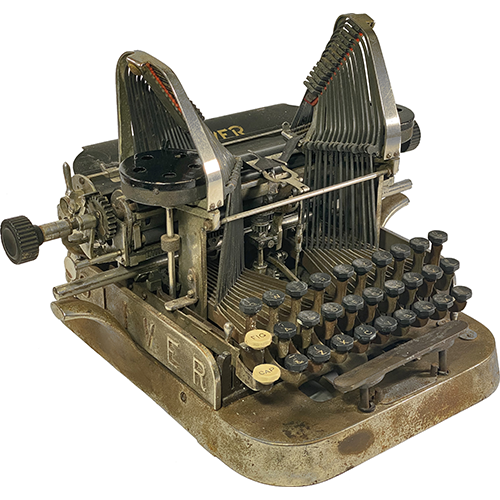 Oliver No. 2 with black character
Oliver No. 2 with black character
keys and white shift keys
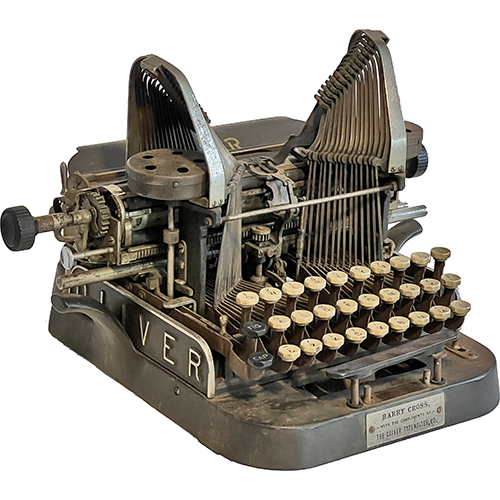 Oliver No. 2 gifted to Head
Oliver No. 2 gifted to Head
Inspector Harry Cross
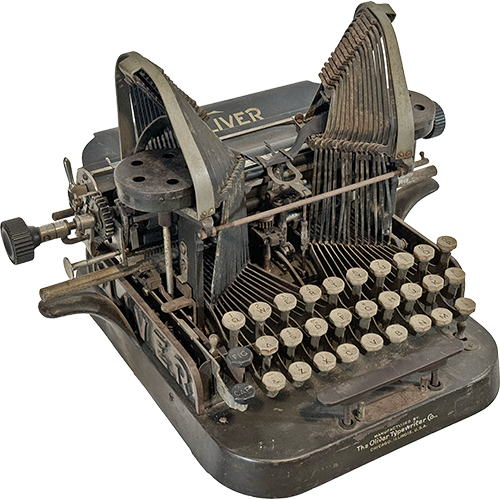 Mid-production Oliver No. 2 with
Mid-production Oliver No. 2 with
enclosed frame under keyboard
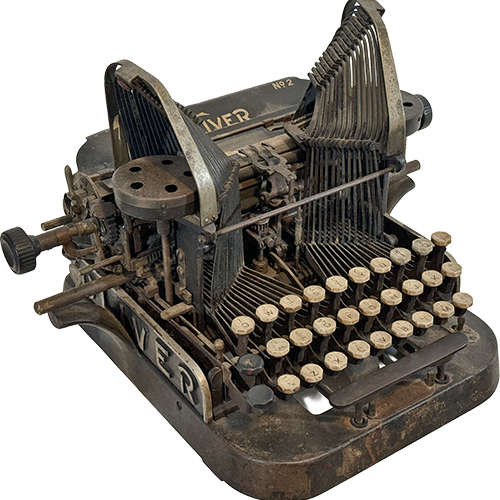 Mid-production Oliver No. 2
Mid-production Oliver No. 2
with opening under keyboard
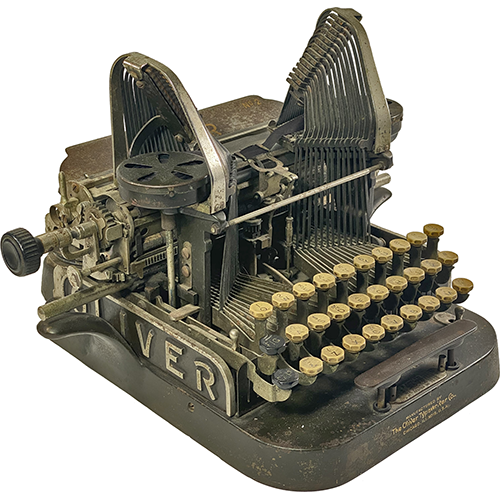 Late production Oliver No. 2
The Oliver No. 2 introduced the iconic curved side handles, as well as a thicker base and updated side panels. Early specimens (seen above) were nickel-plated with black keys, resembling the Oliver No. 1. The No. 2 was also available in an olive green finish with white keys upon request. Over time, olive green became standard and the nickel finish was available upon request. White or black keys could be paired with either finish, if desired. Oliver No. 2 machines sold in Europe were given a left margin release key toward the right of the keyboard. Many features of the No. 2 were updated throughout its production run, most notably the ribbon spool covers and the side panels. Some bases of Oliver No. 2 machines have side handles with flatter ends, mostly earlier examples.
Late production Oliver No. 2
The Oliver No. 2 introduced the iconic curved side handles, as well as a thicker base and updated side panels. Early specimens (seen above) were nickel-plated with black keys, resembling the Oliver No. 1. The No. 2 was also available in an olive green finish with white keys upon request. Over time, olive green became standard and the nickel finish was available upon request. White or black keys could be paired with either finish, if desired. Oliver No. 2 machines sold in Europe were given a left margin release key toward the right of the keyboard. Many features of the No. 2 were updated throughout its production run, most notably the ribbon spool covers and the side panels. Some bases of Oliver No. 2 machines have side handles with flatter ends, mostly earlier examples.
Oliver No. 3
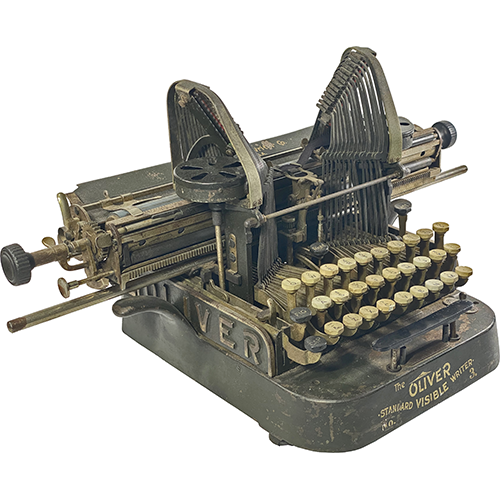 Oliver No. 3 with 15" carriage
Oliver No. 3 with 15" carriage
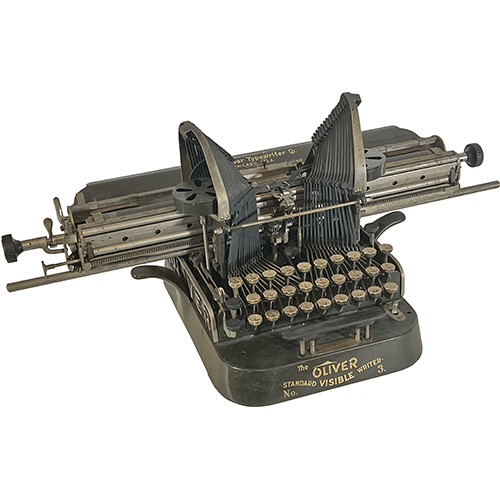 Oliver No. 3 with 18" carriage
Oliver No. 3 with 18" carriage
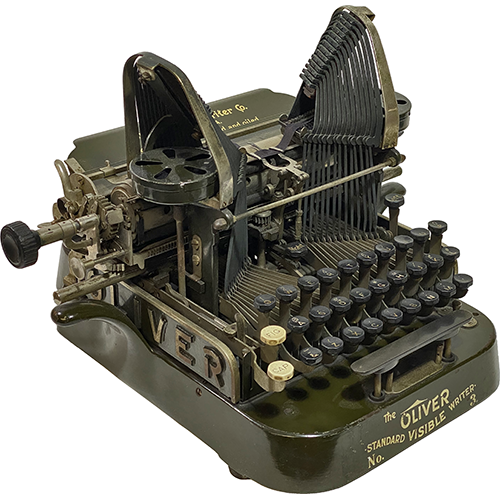 Oliver No. 3 with black character
Oliver No. 3 with black character
keys and white shift keys
The Oliver No. 3 is very similar to the No. 2, with the primary difference being the height of the base. Most Oliver No. 3 machines sold domestically were olive green with white keys but some were nickel-plated upon request. If desired, white key tops could be substituted for black key tops. Minor improvements were common throughout the production of the No. 3, include castings of the base, the shift lock lever, and ribbon boxes. The No. 3 stands as the third-most produced Oliver model of all time.
Oliver No. 5
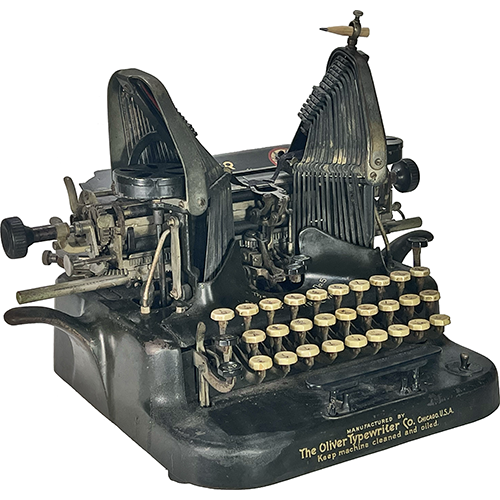 Oliver No. 5 with early ruling device
Oliver No. 5 with early ruling device
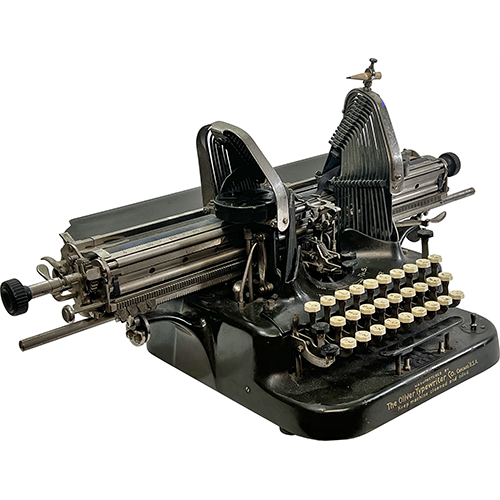 Oliver No. 5 with 18" carriage
The Oliver No. 5 features a completely redesigned base, making the overall size of the machine noticeably larger compared to previous models. The earliest No. 5 machines had a ruling device which held a stick of graphite or an optional wheel attachment, as seen on #188963. This ruling device was eventually updated to accept a standard wooden pencil. Early No. 5 machines have celluloid key covers, which can also been seen on #188963. These key covers were later updated to more traditional key tops. Other notable improvements to the No. 5 include the introduction of the tabulator, backspacer, and an optional typeface called Printype (page 204). These features helped propel the No. 5 to become the second-most produced Oliver model ever.
Oliver No. 5 with 18" carriage
The Oliver No. 5 features a completely redesigned base, making the overall size of the machine noticeably larger compared to previous models. The earliest No. 5 machines had a ruling device which held a stick of graphite or an optional wheel attachment, as seen on #188963. This ruling device was eventually updated to accept a standard wooden pencil. Early No. 5 machines have celluloid key covers, which can also been seen on #188963. These key covers were later updated to more traditional key tops. Other notable improvements to the No. 5 include the introduction of the tabulator, backspacer, and an optional typeface called Printype (page 204). These features helped propel the No. 5 to become the second-most produced Oliver model ever.
Oliver No. 7
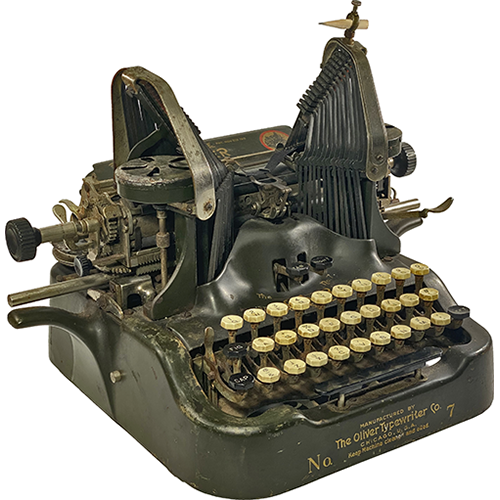 The Oliver No. 7 introduced a new body style that inspired all succeeding downstrike Oliver models. This model is essentially a precursor to the No. 9. The No. 7 is so similar to the No. 9 that it could easily be mistaken for one from a distance. Like previous models, the Oliver No. 7 has capital and figure shift keys only on the left side of the keyboard, whereas the No. 9 has shift keys on both sides. Features unique to the No. 7 include the raised protrusion on the ribbon spool covers, the updated paper bail, and metal clips which secure the ribbon to the ribbon shaft.
The Oliver No. 7 introduced a new body style that inspired all succeeding downstrike Oliver models. This model is essentially a precursor to the No. 9. The No. 7 is so similar to the No. 9 that it could easily be mistaken for one from a distance. Like previous models, the Oliver No. 7 has capital and figure shift keys only on the left side of the keyboard, whereas the No. 9 has shift keys on both sides. Features unique to the No. 7 include the raised protrusion on the ribbon spool covers, the updated paper bail, and metal clips which secure the ribbon to the ribbon shaft.
Oliver No. 9
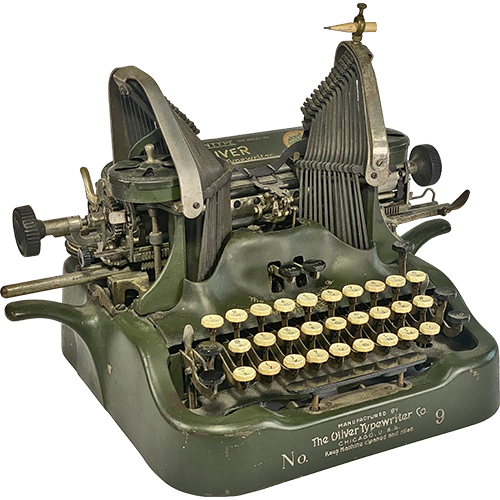
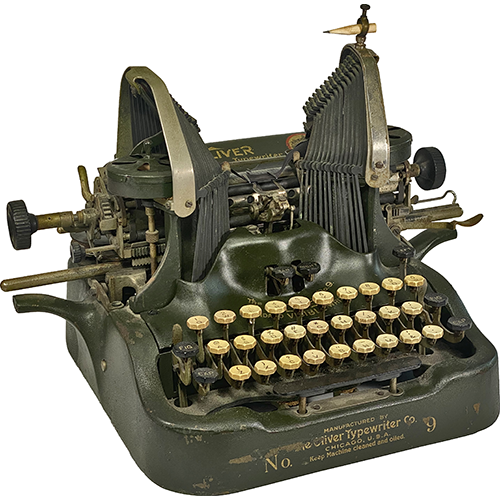 Oliver No. 9 with
Oliver No. 9 with
theAlternate keyboard
The Oliver No. 9 was produced in the largest quantity of any Oliver model. It is essentially an updated version of the No. 7, featuring capital and figure shift keys on both sides of the keyboard and knobs on the ribbon spool covers. The No. 9 uses wooden ribbon spools and has simplified paper bail, both features last seen on Oliver Nos. 5/6.
Oliver No. 11
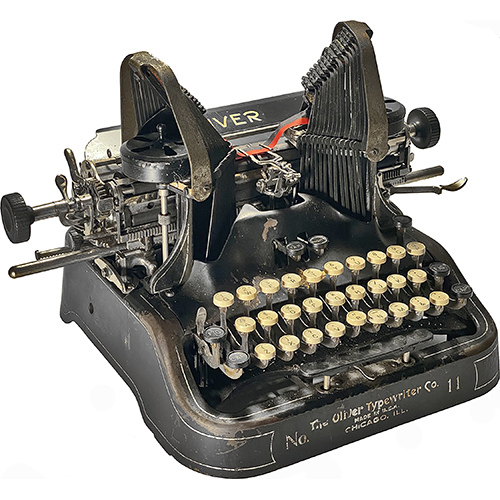 Oliver No. 11 with
Oliver No. 11 with
the Alternate keyboard
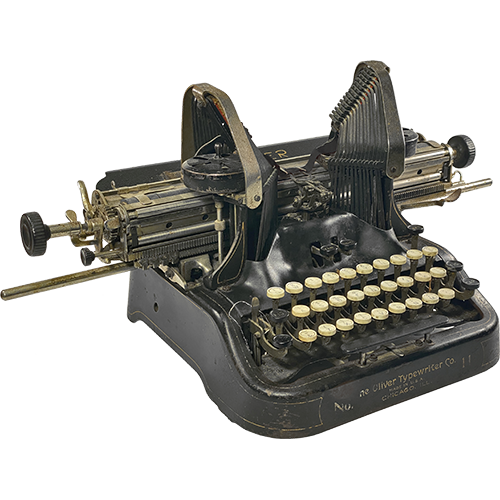 Oliver No. 11 with a 15" carriage
The Oliver No. 11 was the last standard Oliver model produced in the United States. Its base is similar to Nos. 7 and 9, but lacks the classic side handles. The base also features a black finish with gold pinstriping, a significant change from the olive green finish of previous models. The No. 11 also introduced a redesigned decal on the paper table, round key tops, and updated ribbon covers with an inner disk to help manage the ribbon. The No. 11 abandoned the pencil carrier found on the right type tower of every Oliver model since the No. 5. Some Oliver No. 11 machines have the alternate keyboard first introduced on the Oliver No. 9. However, there is no prefix or suffix denoting this keyboard on the No. 11.
Oliver No. 11 with a 15" carriage
The Oliver No. 11 was the last standard Oliver model produced in the United States. Its base is similar to Nos. 7 and 9, but lacks the classic side handles. The base also features a black finish with gold pinstriping, a significant change from the olive green finish of previous models. The No. 11 also introduced a redesigned decal on the paper table, round key tops, and updated ribbon covers with an inner disk to help manage the ribbon. The No. 11 abandoned the pencil carrier found on the right type tower of every Oliver model since the No. 5. Some Oliver No. 11 machines have the alternate keyboard first introduced on the Oliver No. 9. However, there is no prefix or suffix denoting this keyboard on the No. 11.
Oliver No. 15
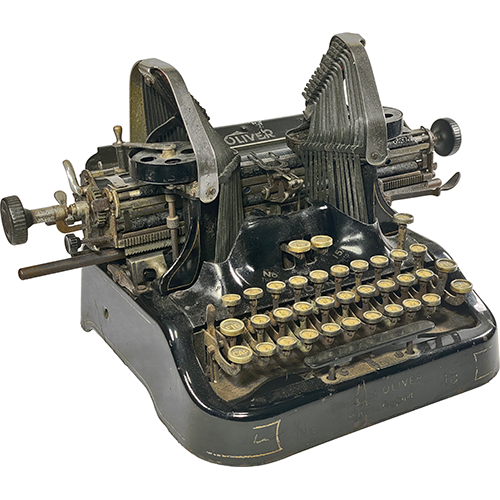 Early Oliver No. 15
Early Oliver No. 15
with ring-and-glass keys
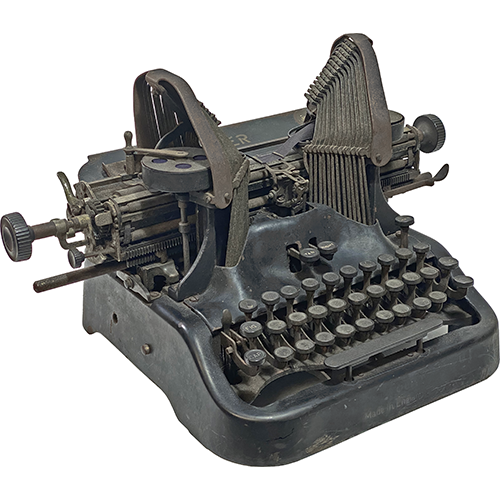 Oliver No. 15 with
Oliver No. 15 with
B-size (12") carriage
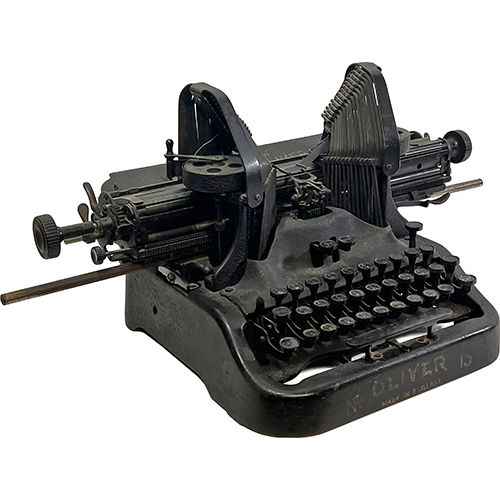 Oliver No. 15 with
Oliver No. 15 with
C-size (15") carriage
The Oliver No. 15 was the first Oliver model produced in England. It resembles the No. 11, but features attached ribbon spool covers, which pivot to access the ribbon. Another noteworthy feature is the letter-designated carriage sizes that are seen on some No. 15 machines. The first 20,000 machines were produced for the general public, including #LC753. Earlier specimens feature ring-and-glass keys, display The British Oliver / Made in England on the front, and have a gloss finish with nickel-plated accents. Over time, the keys changed to black composite and the finish changed to crinkle with blackened accents. An updated front decal displaying OLIVER / MADE IN ENGLAND was initially used alongside the original decal, but eventually replaced the original decal entirely. Starting at #EA20001, the Oliver No. 15 was produced for the British government during World War II. These were all in the latest style produced for the general public, featuring a crinkle finish with blackened accents and black key tops.
Oliver Way-billing Machine/Tabulator
An Oliver No. 2 with a tabulator attachment and an all capital billing keyboard with special shipping characters was originally offered for sale in a standalone brochure as the Oliver Way-billing Typewriter and later in Oliver No. 2 brochures as the Oliver Billing Machine. The combination of tabulator and keyboard/typeface was specifically designed for making way-bills, expense bills, freight bills, invoices, statements, and all forms of tabulated work comprised of columns of figures.
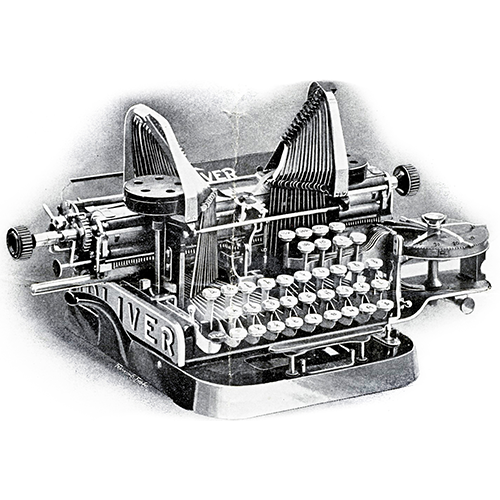 Oliver No. 2 Way-billing machine
Oliver No. 2 Way-billing machine
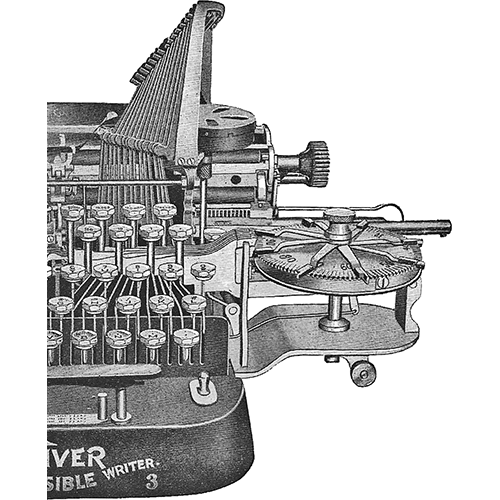 Oliver No. 3 with tabulator
Woodstock
Oliver No. 3 with tabulator
Woodstock
In 1898, the Oliver Typewriter Company manufactured an Oliver No. 2 variant known as the Woodstock for sale by department stores. From September 1898 to January 1899, Detroit’s Board of Education purchasing committee held meetings to discuss purchasing typewriters for use in public high schools. The Linotype Company of Montreal, also known as the Canadian Oliver Typewriter Company, published a pamphlet known as the Battle of Detroit which complied contemporary publications detailing these meetings. According to the pamphlet, an individual referenced as Inspector Marr showed the purchasing committee an advertisement for the Woodstock in the Fall and Winter 1898–99 Montgomery Ward Catalogue, questioning the fairness of the price at which Oliver typewriters had been offered to the Board. W. Waterbury, the general sales manager of the Oliver Typewriter Company, declared the Woodstock an unguaranteed, second-grade machine of which only nineteen were manufactured, all sold to Montgomery Ward. The Oliver Typewriter Company printed an advertisement offering to purchase twenty Woodstock typewriters for a substantial amount of money, reinforcing the fact only nineteen were manufactured. Manufacturing of the Woodstock ceased after it had been on the market for less than ten months.
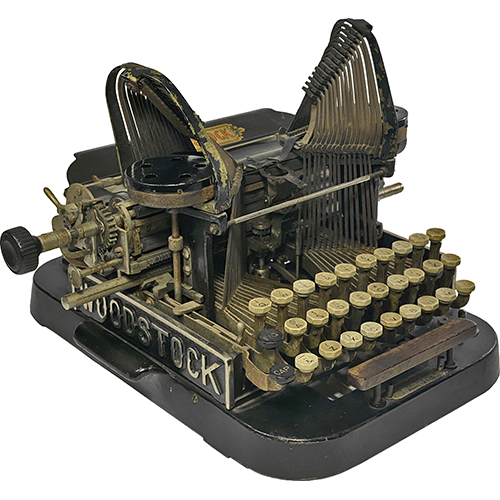
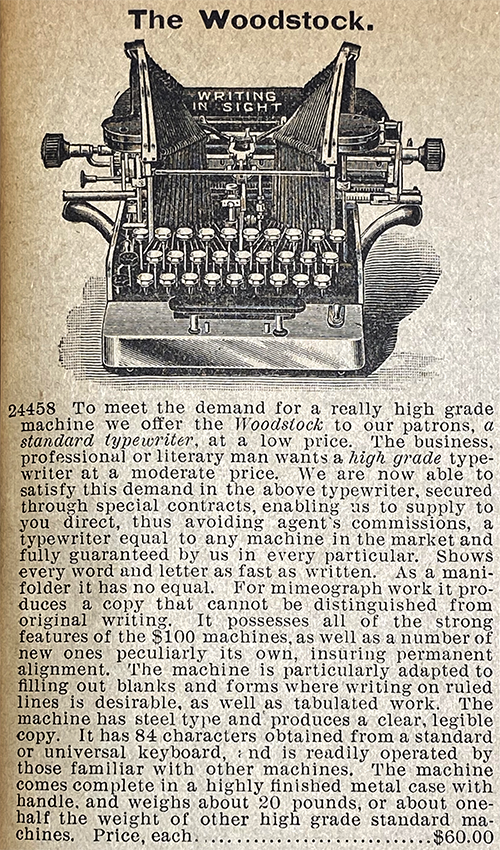 Woodstock advertisement from the Fall and
Woodstock advertisement from the Fall and
Winter 1898–1899 Montgomery Ward Catalogue
Export Models
Oliver Nos. 4, 6, 8, 10, 12, and 16 are 32-key export versions of their respective preceding odd-numbered model. These models, excluding the British-made No. 16, were manufactured in the United States and sold throughout Europe. Export models were often equipped with keyboards of various foreign languages. Some export models were also nickel-plated for Latin American markets. Even-numbered export models were produced in quantities much lower than their odd-numbered counterparts. Note that Oliver Nos. L-10 and L-12 are nickel-plated versions of the 28-key Nos. 9 and 11, respectively, and are therefore not 32-key export models.
Oliver No. 4
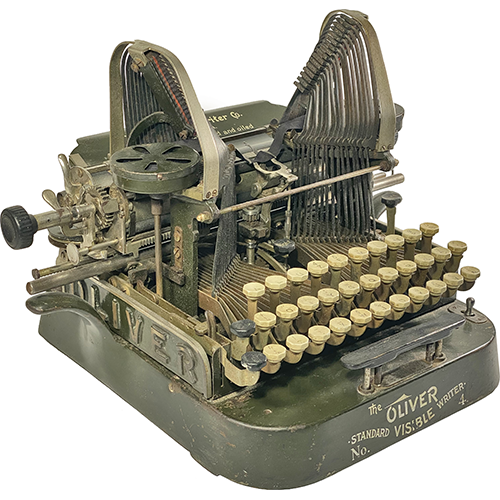 Oliver No. 4
The Oliver No. 4, the first export Oliver model, is a 32-key version of the preceding odd-numbered model, the No. 3., It was introduced in 1904, three years after the introduction of the Oliver No. 3.
Oliver No. 4
The Oliver No. 4, the first export Oliver model, is a 32-key version of the preceding odd-numbered model, the No. 3., It was introduced in 1904, three years after the introduction of the Oliver No. 3.
Oliver No. 6
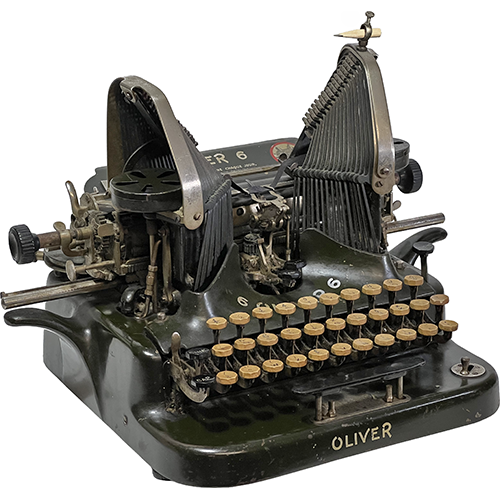 Oliver No. 6 with
Oliver No. 6 with
French keyboard
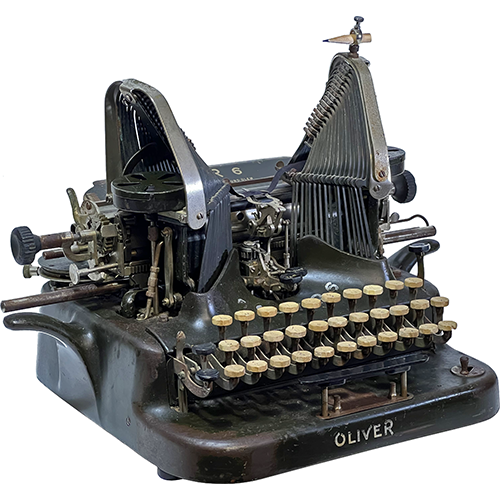 Oliver No. 6 with
Oliver No. 6 with
German keyboard
The Oliver No. 6 is the 32-key export version of the No. 5. Updates made to the No. 5 throughout production also found their way onto the No. 6, although some updates were more sporadic, such as the introduction of the backspacer. The serial numbers of the Oliver No. 6 continue incrementing with a “D” prefix from where the Oliver No. 4 numbers ended, with the exception of Oliver No. 4 machines placed by special order during Oliver No. 6 production. Oliver No. 6 #D4301 was equipped with a French keyboard and was manufactured before the introduction of the tabulator. Oliver Nos. 6 and 10 are the most common export Oliver models.
Oliver No. 8
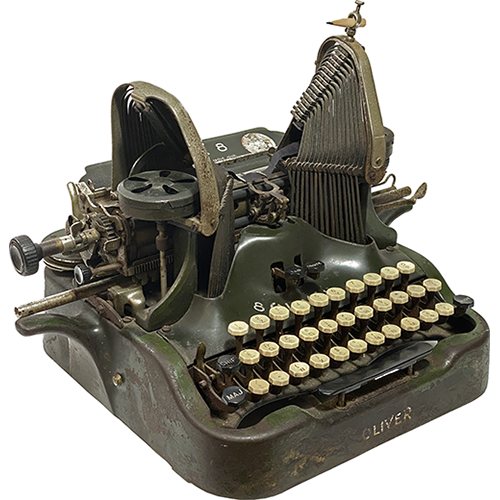 Oliver No. 8 with
Oliver No. 8 with
French keyboard
The Oliver No. 8 is the 32-key export version of the No. 7. It was produced in very limited numbers compared to other export models. Oliver No. 8 #D31283 has a French keyboard. The No. 8 continues following the export serial numbers using a “D” prefix. However, there is approximately a 10,000-number jump between the last No. 6 and the first No. 8 produced (#D21000 to #D31001).
Oliver No. 10
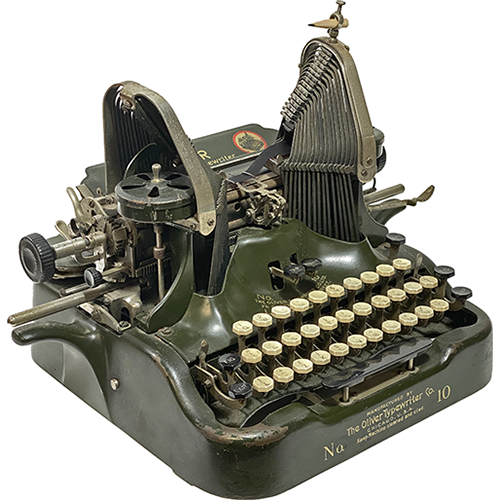 Oliver No. 10 with
Oliver No. 10 with
Dutch keyboard
The Oliver No. 10 is the 32-key export version of the No. 9. Oliver Nos. 10 and 6 are the most common export Oliver models. The Oliver No. 10 follows the export serial number scheme, but with an “R” prefix instead of “D”. There is also a number jump from the end of the Oliver No. 8 serial numbers, similar to the jump between Oliver Nos. 6 and 8.
Oliver No. 12
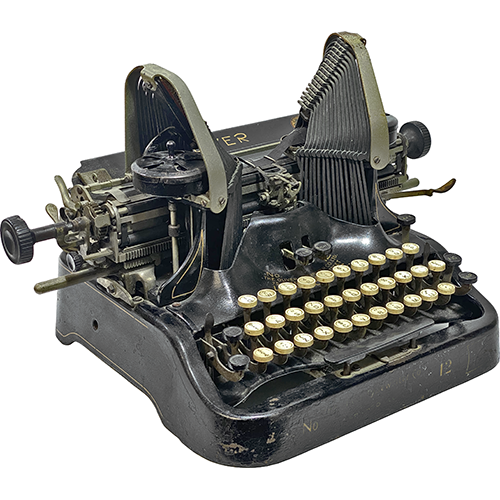 Oliver No. 12 with
Oliver No. 12 with
French keyboard
The Oliver No. 12 was the last 32-key export model produced in the United States. Although it is the export version of the Oliver No. 11, the No. 12 unusually does not follow the export serial number scheme. Instead, they are intermixed with the No. 11 serial numbers. Oliver No. 12 #1021181 has a Dutch keyboard and a 12” carriage.
Oliver No. 16
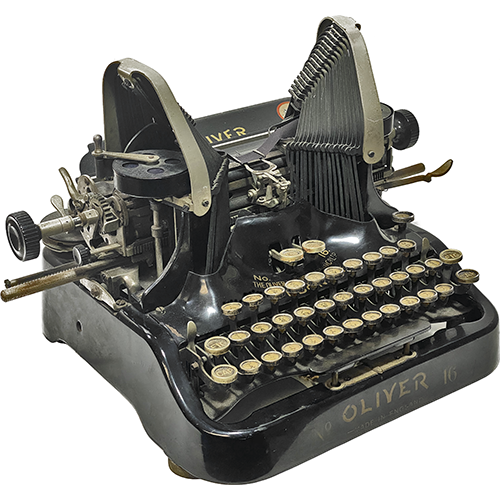 Oliver No. 16 with
Oliver No. 16 with
Dutch keyboard
The Oliver No. 16 was the only 32-key export Oliver model produced in England. The No. 16 machines are styled like early specimens of the No. 15. The Oliver No. 16 follows a unique set of serial numbers with an “0A” prefix which later changed to an “R” prefix.
Linotype Co./Canadian Models
John Redpath Dougall was born on August 17, 1841 in Montréal, Quebec, Canada, to Scottish-born merchant John Dougall, founder the Montreal Witness newspaper. In 1871, the father relocacted to New York City where he founded the Daily Witness and New York Weekly newspapers, leaving his son in charge of the Montreal Witness. In 1891, John Redpath Dougall founded The Linotype Company, which manufactured typesetting machines known as the Linotype at 156 St. Antoine Street, Montréal. In 1898, the Linotype Company expanded to manufacture versions of the Oliver No. 2 and, in 1901, the Oliver No. 3, for Canadian and South American markets. In 1904, Dougall sold the Linotype division of his company to the Toronto Type Foundry, and rebranded the typewriter division as the Canadian Oliver Typewriter Company. The Canadian Oliver Typewriter Company eventually stopped manufacturing machines and by 1912, focused solely on nickel plating and polishing.
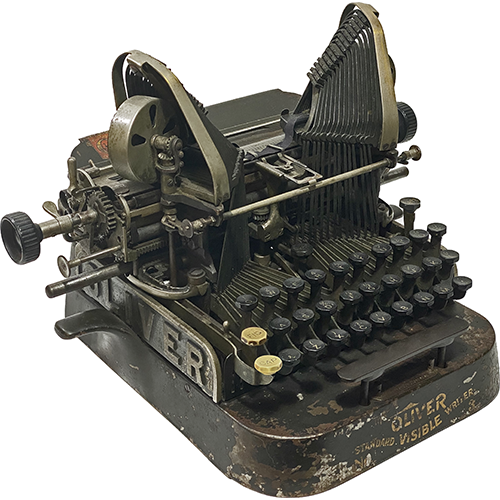 Early Canadian Oliver No. 3
Early Canadian Oliver No. 3
with vertical ribbon spools
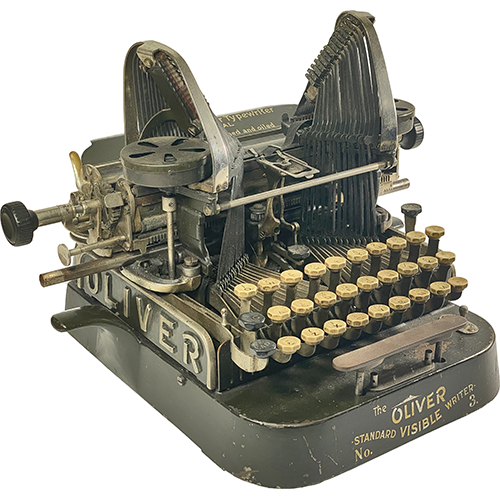 Late Canadian Oliver No. 3
Latin American Models
Late Canadian Oliver No. 3
Latin American Models
The Oliver Typewriter Company marketed most Oliver models in Latin America through Compania Parker S.A., operated by William Archer Parker, the Oliver Typewriter Company’s Latin American sales agent. Oliver Nos. L-10 and earlier were nickel plated by default, with olive green finishes furnished upon request. Oliver Nos. L-12 and L-13 were only nickel plated. The Linotype Company/Canadian Oliver Typewriter Company also manufactured Oliver typewriters for sale in South America.
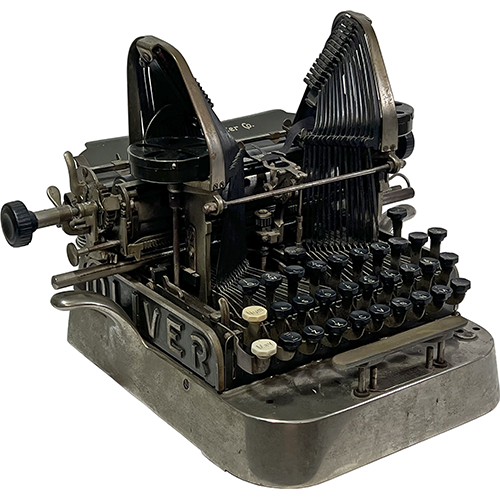 Oliver (Latina) No. 3
Oliver (Latina) No. 3
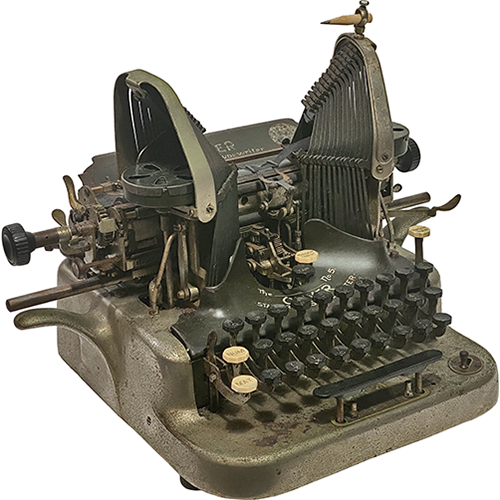 Oliver (Latina) No. 5
Oliver (Latina) No. 5
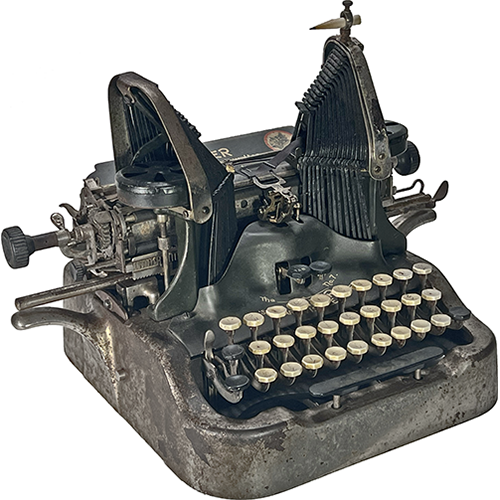 Oliver (Latina) No. 7
Oliver (Latina) No. 7
Oliver No. L-10
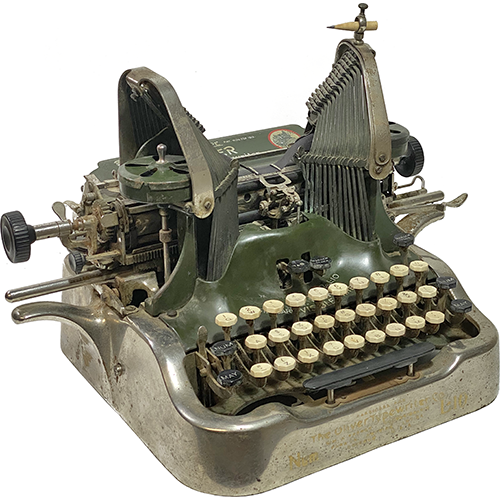 Oliver No. L-10
The Oliver No. 9 was rebranded for Latin America as the Oliver No. L-10. Some versions have no branding below the keyboard, while others have a decal (as seen above) or red plaque. Some Oliver No. L-10 machines were painted olive green by special order.
Oliver No. L-10
The Oliver No. 9 was rebranded for Latin America as the Oliver No. L-10. Some versions have no branding below the keyboard, while others have a decal (as seen above) or red plaque. Some Oliver No. L-10 machines were painted olive green by special order.
Oliver Nos. L-12 & L-13
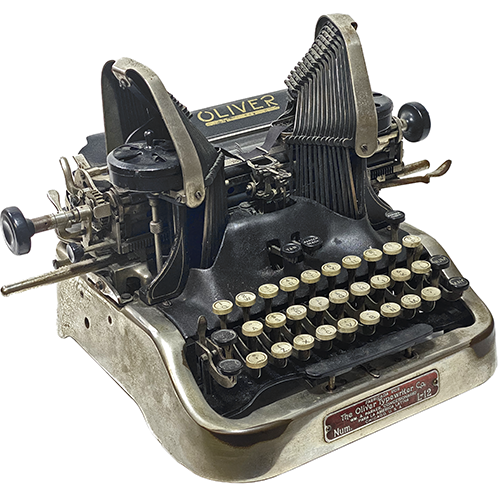 Oliver No. L-12
Oliver No. L-12
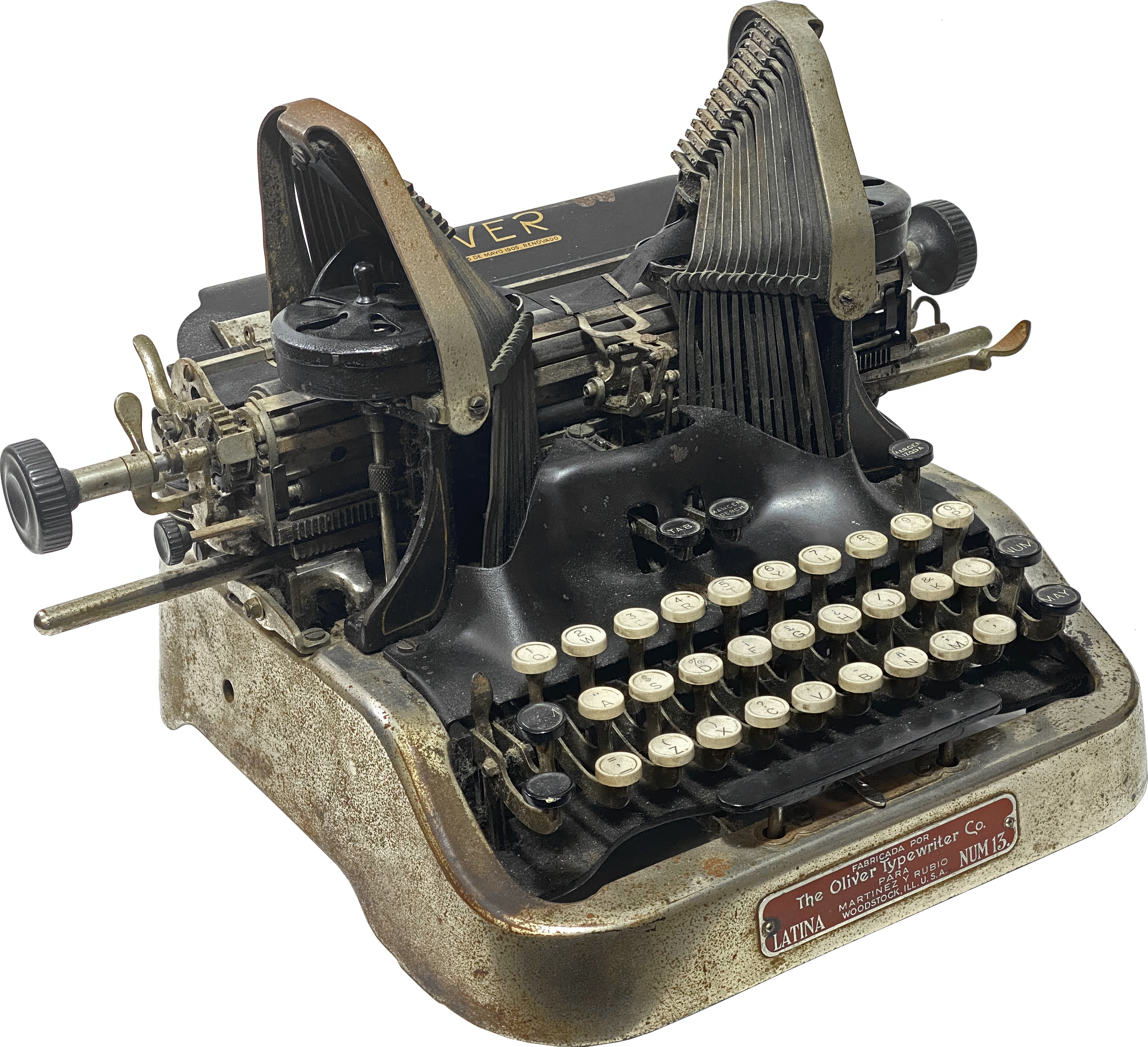 Oliver No. L-13
The Oliver No. L-12 was the original Latin American version of the Oliver No. 11. The No. L-12 and previous Latin American models manufactured in the United States were distributed by Compania Parker S.A., as mentioned on the rear plaque of the machine (shown at right). This plaque also describes the No. L-12 as a silent model.
Oliver No. L-13
The Oliver No. L-12 was the original Latin American version of the Oliver No. 11. The No. L-12 and previous Latin American models manufactured in the United States were distributed by Compania Parker S.A., as mentioned on the rear plaque of the machine (shown at right). This plaque also describes the No. L-12 as a silent model.
Towards the end of production of the Oliver No. 11, the No. L-12 was replaced by the No. L-13 because the distributer changed from Compania Parker S.A. to Martinez y Rubio. The Oliver No. L-13 displays front and rear plaques just like the No. L-12, but now reflect the new distributor. The rear plaque (shown at right) no longer describes the machine as a silent model.
Revilo Olivers
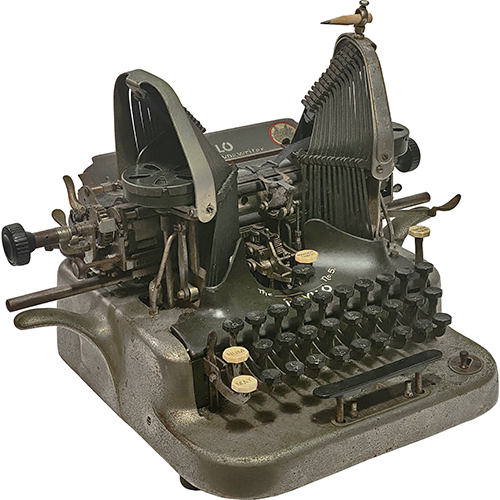 Revilo No. 5
Revilo No. 5
Render
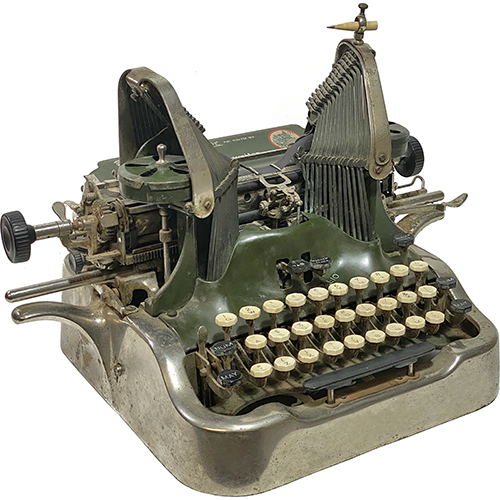 Revilo No. L-10
Revilo No. L-10
Render
In Argentina, various Oliver models were branded as Revilo (Oliver spelled backwards) because Oliver was already trademarked. Beginning in 1903, typewriter supplies were also marketed by Oliver domestically under the Revilo name.
Fabrik Stolzenberg Models
Fabrik Stolzenberg, Deutsche Einrichtungs-gesellschaft m.b.H. was the primary distributor of Oliver typewriters in Germany. The company, owned by Gustav Metz, was based in Oos, Baden-Baden, with subsidiaries in Berlin, Cologne, and Hamburg. All Oliver machines distributed by Fabrik Stolzenberg have white margin release keys as opposed to black.
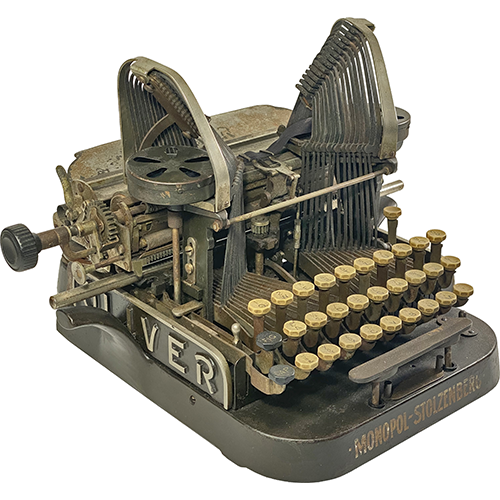 Oliver Monopol-Stolzenberg No. 2
Oliver Monopol-Stolzenberg No. 2
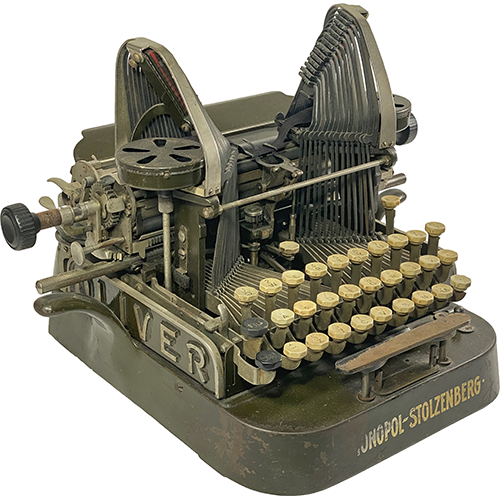 Oliver Monopol-Stolzenberg No. 3
Oliver Monopol-Stolzenberg No. 3
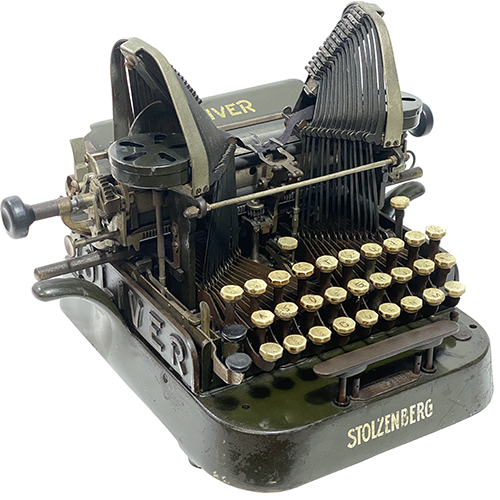 Oliver Stolzenberg No. 3
Oliver Stolzenberg No. 3
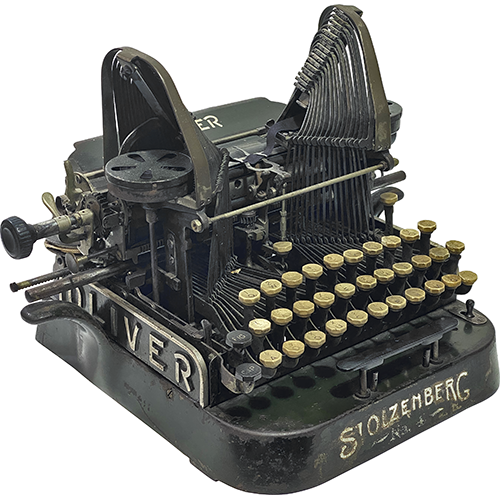 Oliver Stolzenberg No. 4
Oliver Stolzenberg No. 4
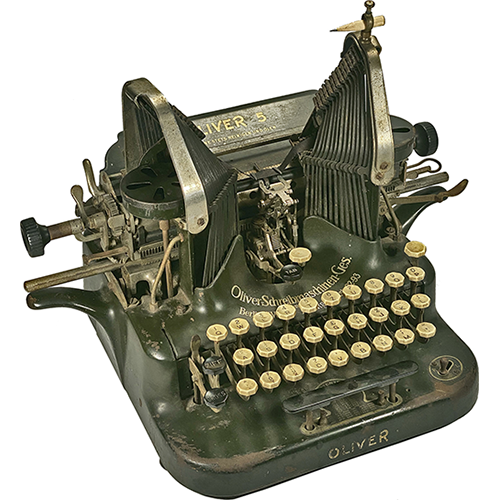 Oliver Schreibmaschinen-Gesellschaft No. 5
A. Greger & Co. Models
Oliver Schreibmaschinen-Gesellschaft No. 5
A. Greger & Co. Models
A bicycle manufacturer in Vienna, Austria known as A. Greger & Company produced the Oliver No. 3 as the Courier from 1903 to 1919. Parts already manufactured were still being assembled until 1927. The only major difference between the Oliver No. 3 and the earlier Courier machines (aside from the name) is the ring-and-glass key tops.
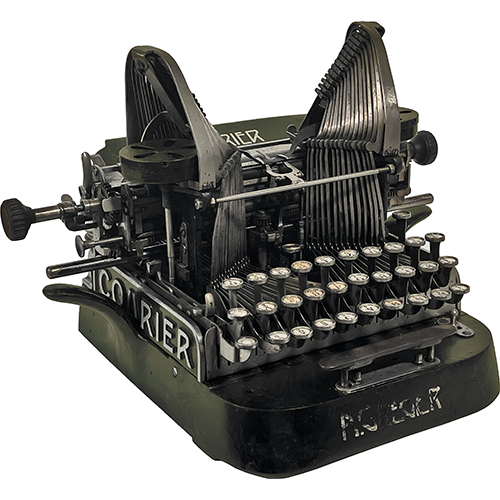 Courier (Early)
Courier (Early)
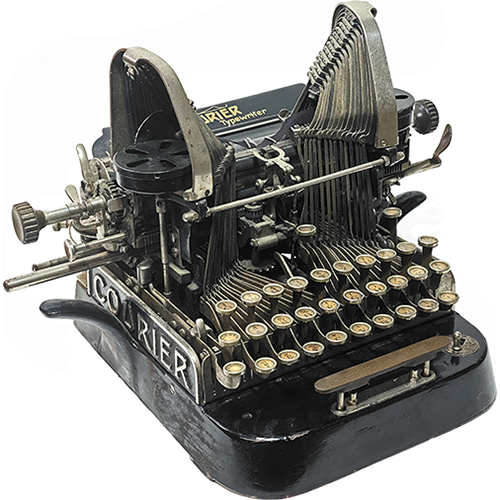 Courier (Late)
Courier (Late)
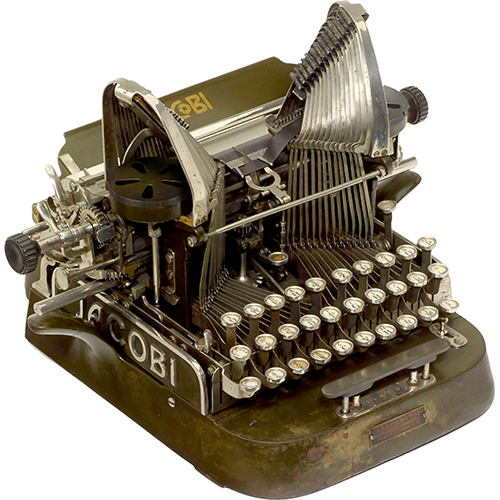 Jacobi
Jacobi
Courtesy Auction Team Breker
www.breker.com
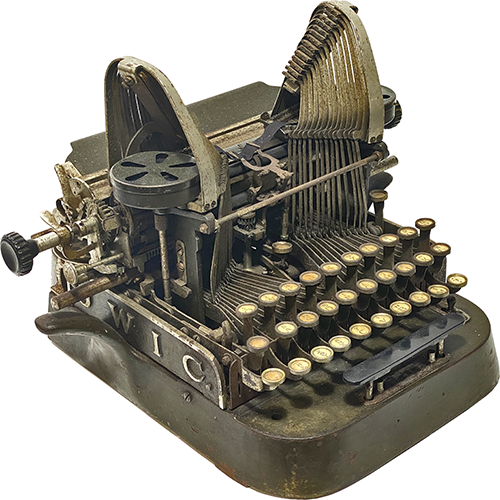 Jwic
When the Oliver No. 5 was introduced in the United States, the type guards of Courier machines used the new Oliver No. 5 style. The olive green finish was then discontinued in favor of black. At this time, the Courier’s paper table decal was updated to display The Courier Typewriter as opposed to Courier. The ribbon reverse plaque also changed to the style of Oliver No. 5 machines. Finally, a backspacer was added to the Courier once it was introduced on the Oliver No. 5.
Jwic
When the Oliver No. 5 was introduced in the United States, the type guards of Courier machines used the new Oliver No. 5 style. The olive green finish was then discontinued in favor of black. At this time, the Courier’s paper table decal was updated to display The Courier Typewriter as opposed to Courier. The ribbon reverse plaque also changed to the style of Oliver No. 5 machines. Finally, a backspacer was added to the Courier once it was introduced on the Oliver No. 5.
A variant of the Courier was produced for a German office equipment dealer in Munich under the name Jacobi, which was also the name of the sewing machine division of A. Greger & Company.
A Czech variant of the Courier was produced as the Jwic.
Remodelled (RM) Oliver Models
The Oliver Typewriter (Sales) Company remodelled some olive green Oliver models in the style of Oliver Nos. 11/12 and 15/16 machines— black with gold pinstriping. Earlier specimens kept the original decal below the keyboard (as seen above). The Remodelled Oliver machines were given new serial numbers with an RM prefix in place of the original numbers on the frames. The carriages were stripped of their original serial numbers with no new number in place.
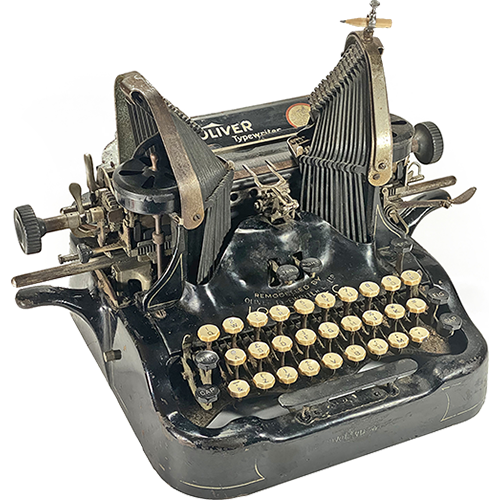 RM Oliver No. 9 (Early)
RM Oliver No. 9 (Early)
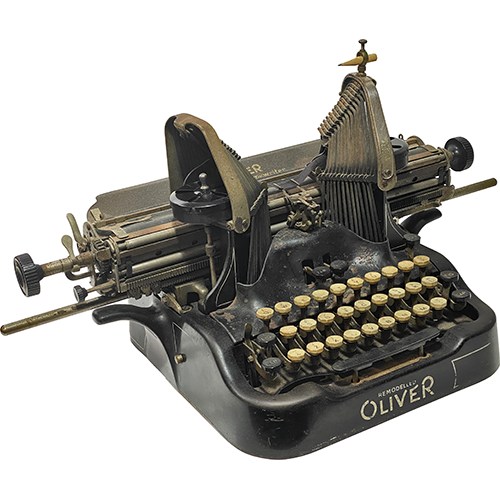 RM Oliver No. 9 (Late)
RM Oliver No. 9 (Late)
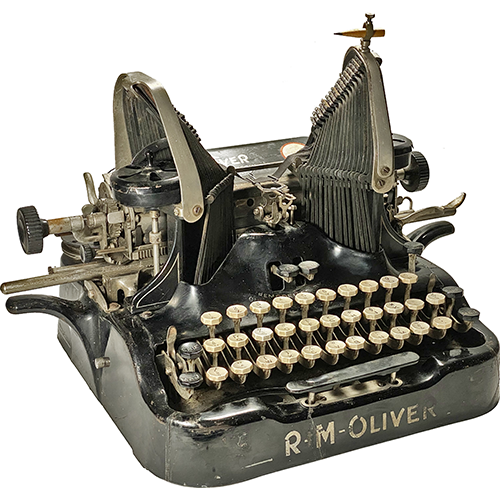 RM Oliver No. 10
Four Bank Desktop Models
RM Oliver No. 10
Four Bank Desktop Models
The first instance of a four bank desktop Oliver occurred in the early 1920s, when Theron Knapp, Chief Design Engineer of the Oliver Typewriter Company, presented to the Oliver Board of Directors his new four bank typewriter prototype. This machine was designed to resemble typewriters of other brands on the market at the time. It still featured the iconic Oliver typebars, but they were angled to swing towards the platen from the front instead of downward. Despite its novel design, the prototype never reached production due to the Depression of 1921–22. Photos of this prototype were once owned by Chester Nelson, Chief Cost Analyst of the Oliver Typewriter Company.
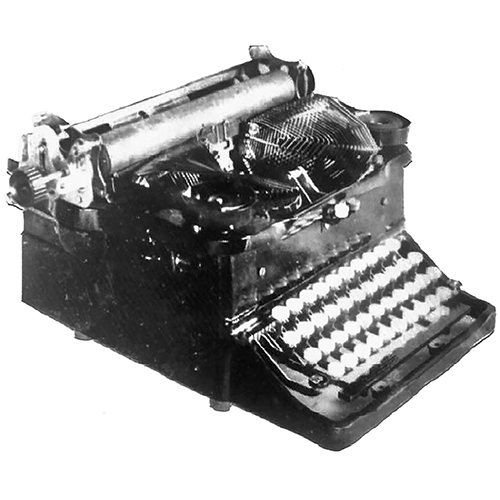 Oliver Four Bank Prototype
Oliver Four Bank Prototype
Oliver Four Bank
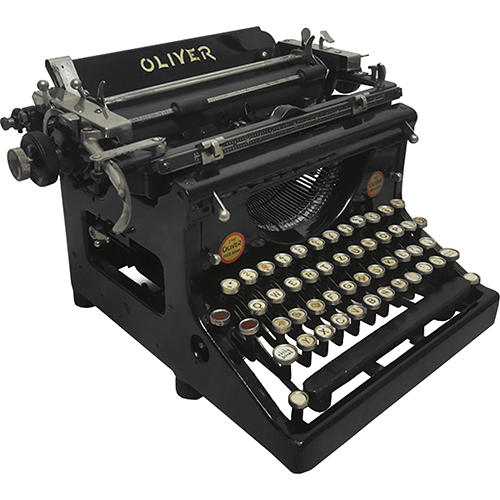 Oliver Four Bank
The first commercially available four bank desktop Oliver was sold by British Oliver from 1931 to 1935. The Fortuna IV was rebranded and sold as the Oliver Four Bank, without any model number designation. Parts were manufactured by Fortuna Büromaschinen GmbH in Berlin, Germany but the machines were assembled at the Oliver factory in Croydon, England.
Oliver Four Bank
The first commercially available four bank desktop Oliver was sold by British Oliver from 1931 to 1935. The Fortuna IV was rebranded and sold as the Oliver Four Bank, without any model number designation. Parts were manufactured by Fortuna Büromaschinen GmbH in Berlin, Germany but the machines were assembled at the Oliver factory in Croydon, England.
Oliver Nos. 20 & 21
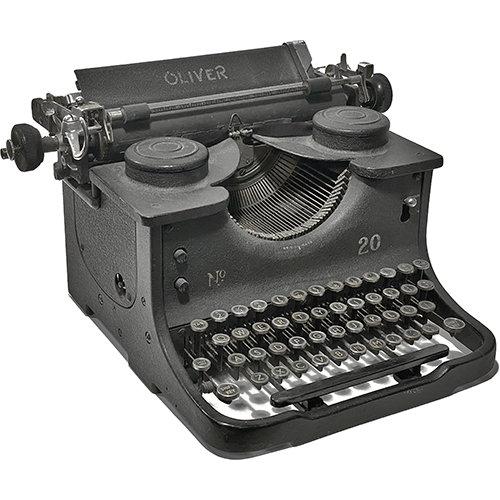 Oliver No. 20
Oliver No. 20
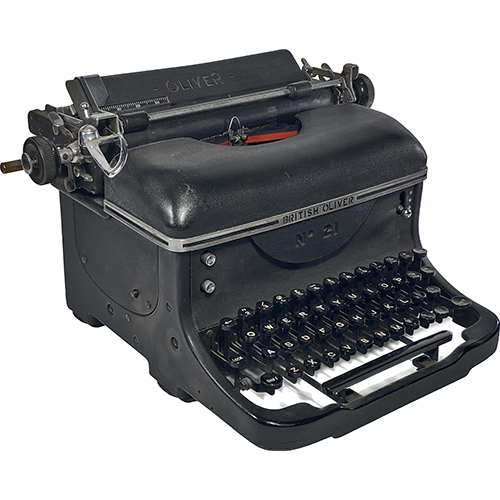 Oliver No. 21
The Oliver Four Bank was replaced by the Oliver No. 20, a rebranded Halda-Norden No. 5, manufactured in Svängsta, Sweden. When the No. 20 was first introduced, it was sometimes advertised as an Oliver Four Bank without a model number. Early production Oliver No. 20 machines display "The Oliver Four Bank" in the iconic red Oliver circle, "The British Oliver" on the paper table, "BRITISH MADE THROUGHOUT" around the curve of the type basket, and "OLIVER 20" on the frame below the keyboard. Late production Oliver No. 20 machines display "BRITISH MADE", around the curve of the type basket, "OLIVER" on the paper table, and "No. 20" above the keyboard. Late production Oliver No. 20 machines display "BRITISH MADE", around the curve of the type basket, "OLIVER" on the paper table, and "No. 20" above the keyboard.
Oliver No. 21
The Oliver Four Bank was replaced by the Oliver No. 20, a rebranded Halda-Norden No. 5, manufactured in Svängsta, Sweden. When the No. 20 was first introduced, it was sometimes advertised as an Oliver Four Bank without a model number. Early production Oliver No. 20 machines display "The Oliver Four Bank" in the iconic red Oliver circle, "The British Oliver" on the paper table, "BRITISH MADE THROUGHOUT" around the curve of the type basket, and "OLIVER 20" on the frame below the keyboard. Late production Oliver No. 20 machines display "BRITISH MADE", around the curve of the type basket, "OLIVER" on the paper table, and "No. 20" above the keyboard. Late production Oliver No. 20 machines display "BRITISH MADE", around the curve of the type basket, "OLIVER" on the paper table, and "No. 20" above the keyboard.
The successor to the Oliver No. 20, a rebranded Halda-Norden No. 5, is naturally the Halda-Norden No. 6, rebranded as the Oliver No. 21. It was manufactured at the Halda-Norden factory in Svängsta, Sweden. Initially, the Oliver No. 20 machines were black with a debosssed model number above the keyboard. Late production Oliver No. 21 machines were produced in gray and have a plaque that displays Model 21.
Portable Models
In the early 1930s, Europa Typewriters AG began producing a small portable typewriter branded as Europa. Around this time, Oliver Typewriter (Italy) Ltd. was founded with a factory and headquarters located in Milan. They began producing an Oliver portable with the same body style as the Europa. Fortuna Büromaschinen GmbH of Berlin, Germany, also produced the Europa portable under the Oliver name. In April 1932, when Oliver Typewriter (Italy) was liquidated, Società Industriale Meccanica (SIM) of Turin, Italy, began manufacturing the Europa portable as Oliver. This body style was also sold under the names Augusta Monaco, Edelweiss, Fortuna, Imperia, Junior, Sabaudia, SIM, and SIM-Italia. These machines were branded with Oliver above the keyboard by either a decal displaying The OLIVER (the same decal used on downstrike machines) or an embossed OLIVER plaque. A large variety of colors and finishes were produced. Machines of the earliest variation are typically found with serial numbers in the 3000s, many with a Z prefix. This early variation has an unaccented ribbon reverse above the keyboard to the left and ribbon selector to the right. The next variation is the same as the earliest version except it lacks the ribbon selector. These often have serial numbers in the 20000s, some with a K prefix. Some have the ribbon reverse accented in metal trim while others remain unaccented. The most common variation is almost identical to the earliest variation except for its ribbon reverse and selector accented in metal trim. The last variation has the ribbon reverse on the side of the machine instead of above the keyboard. SIM continued to manufacture five other body styles, three of which were also branded with the Oliver name. Some of these portables were assembled by the Oliver Typewriter Manufacturing Company at their factory in Croydon, England.
Oliver Portable (Europa/SIM)
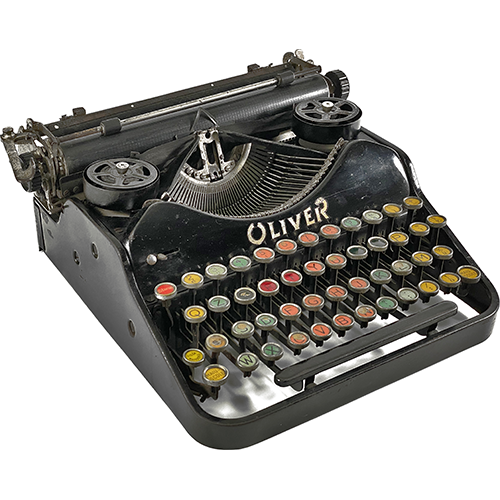 Oliver Portable (Europa, Early)
Oliver Portable (Europa, Early)
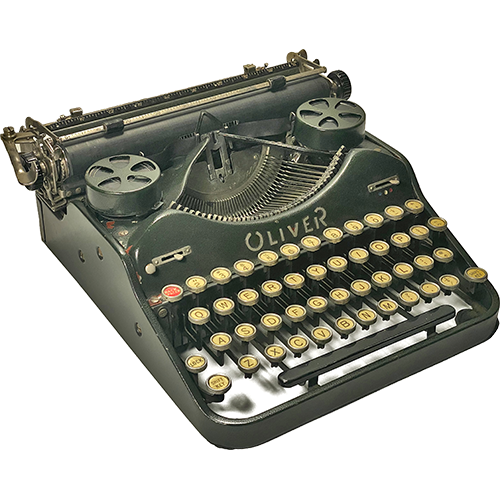 Oliver Portable (Europa, Late)
Oliver Portable (Europa, Late)
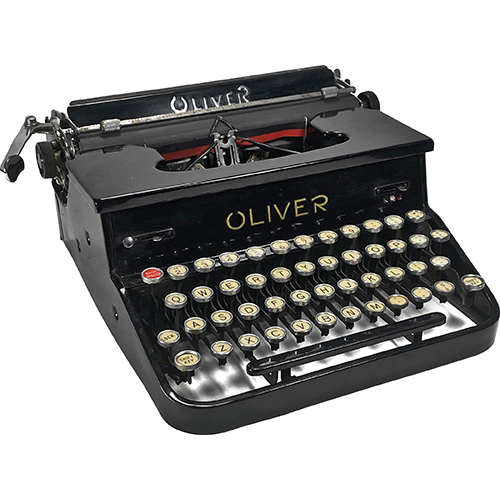 Oliver Portable (Astoria)
Oliver Portable (Astoria)
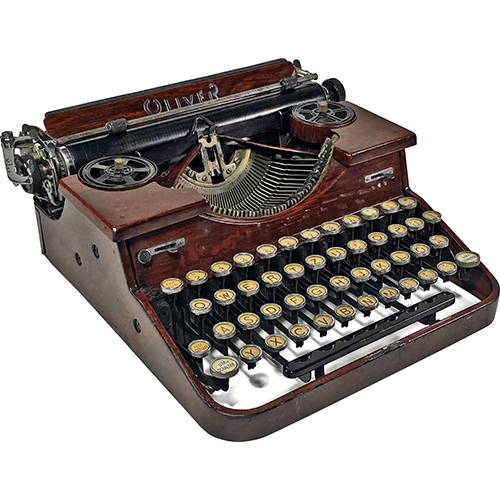 Oliver Portable (Littoria)
Oliver Portable (Littoria)
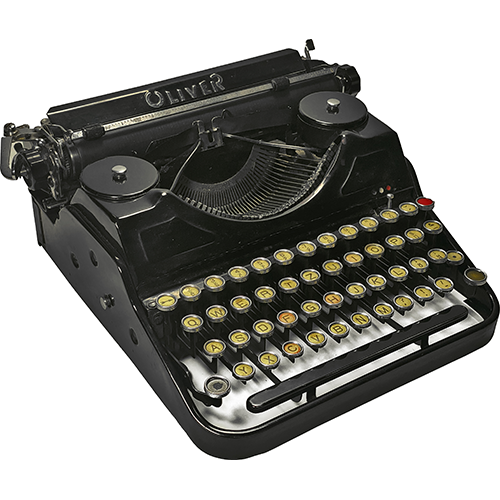 Oliver Portable (SIM Model 6)
Oliver Portable (SIM Model 6)
Oliver Portable (Patria)
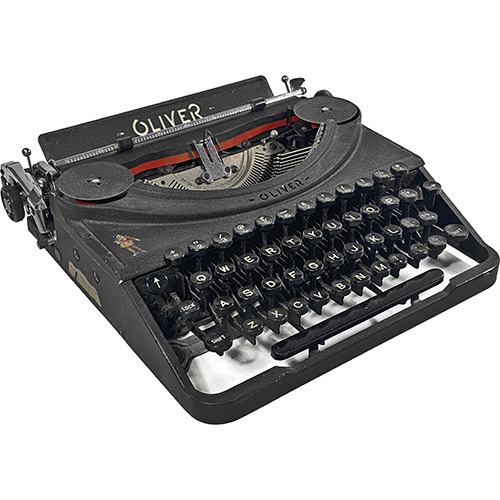 Oliver Patria (Black)
Oliver Patria (Black)
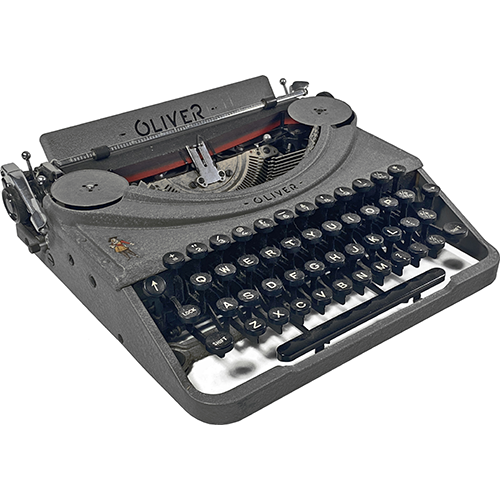 Oliver Patria (Grey)
From 1948 to 1954, the Oliver Portable was a rebranded Patria produced by August Birchmeier’s Söhne in Canton of Aargau, Switzerland. Early iterations were only offered in black with ring-and-glass keys and an Oliver decal above the keyboard. The portable was updated with a cutout logo above they keyboard and a decal of Oliver Cromwell, a 17th century English political leader. The Oliver typewriter was often compared to Oliver Cromwell, exemplifying each as a successful Oliver of their respective eras. The ring-and-glass keys were soon changed to black composite keys. A gray color option was also introduced. In 1954, the Oliver Cromwell decal was no longer added.
Oliver Patria (Grey)
From 1948 to 1954, the Oliver Portable was a rebranded Patria produced by August Birchmeier’s Söhne in Canton of Aargau, Switzerland. Early iterations were only offered in black with ring-and-glass keys and an Oliver decal above the keyboard. The portable was updated with a cutout logo above they keyboard and a decal of Oliver Cromwell, a 17th century English political leader. The Oliver typewriter was often compared to Oliver Cromwell, exemplifying each as a successful Oliver of their respective eras. The ring-and-glass keys were soon changed to black composite keys. A gray color option was also introduced. In 1954, the Oliver Cromwell decal was no longer added.
Oliver Courier
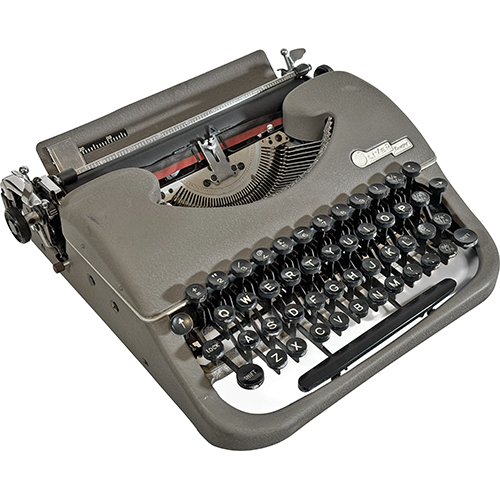 Oliver Courier (Early)
Oliver Courier (Early)
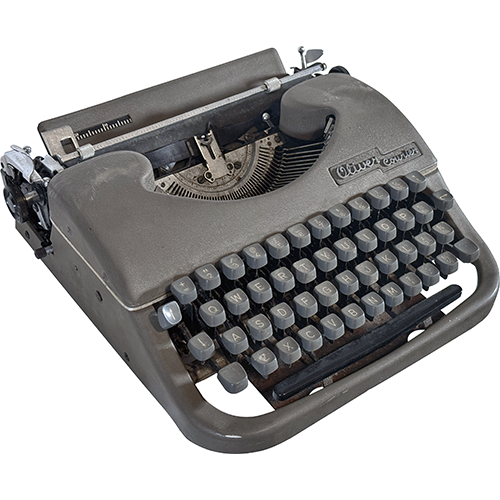 Oliver Courier (Mid-production)
Oliver Courier (Mid-production)
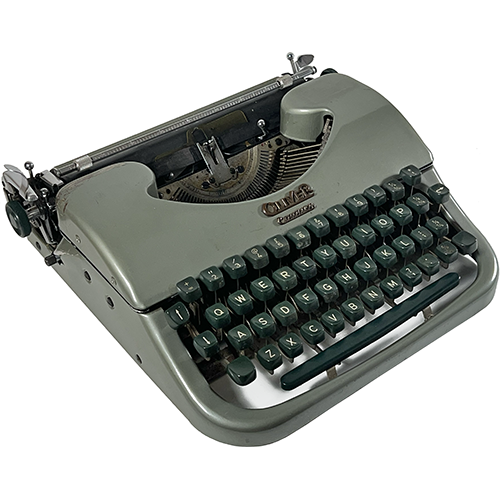 Oliver Courier (Late)
Oliver Courier (Late)
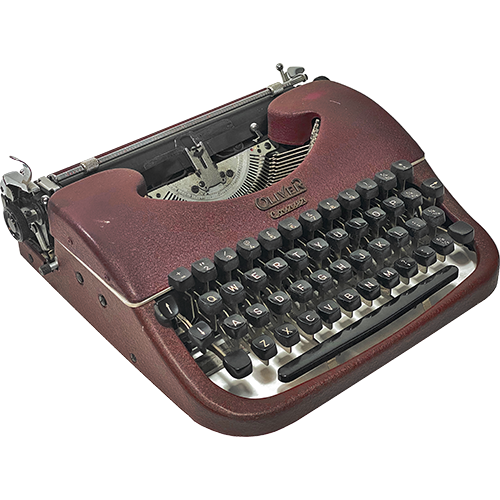 Oliver Courier (Late)
Oliver Courier (Late)
 Oliver Courier (Late)
Oliver Courier (Late)
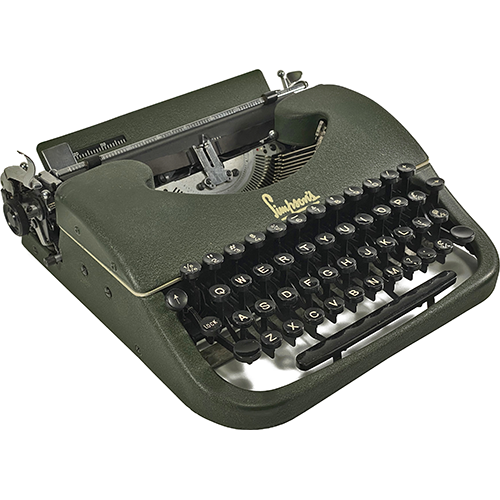 Simpson's
Simpson's
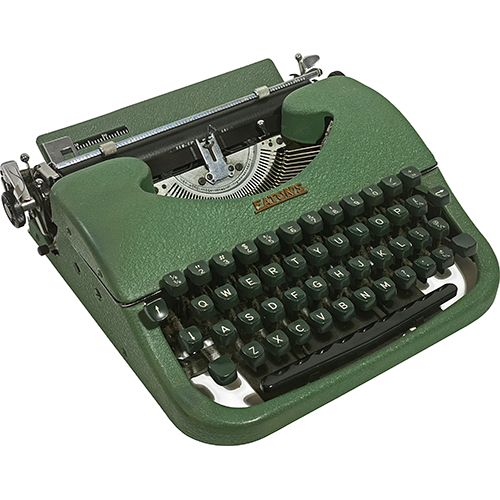 Eaton's
The successor to the Oliver Portable (Patria) was branded as the Oliver Courier from 1954 to 1959 and was manufactured by August Birchmeier’s Söhne in Canton of Aargau, Switzerland. They originally produced this machine as the Swissa Piccola. In France, it was sold as the Byron, Japy P68, Japy Personelle, Patria, Typo, and Select. The French watch company Japy Freres & Cie manufactured this machine through a licensing agreement. Guillermo Trúniger, S.A. distributed this machine in Spain under the names Amaya, Florida, Königer, Patria, and Pulasatta, and exported it in small quantities. Voss sold this body style as the Privat in Western Germany. Early production Oliver Courier machines, produced in black or gray with round, black keys, feature a recessed badge toward the right of the cover.
Eaton's
The successor to the Oliver Portable (Patria) was branded as the Oliver Courier from 1954 to 1959 and was manufactured by August Birchmeier’s Söhne in Canton of Aargau, Switzerland. They originally produced this machine as the Swissa Piccola. In France, it was sold as the Byron, Japy P68, Japy Personelle, Patria, Typo, and Select. The French watch company Japy Freres & Cie manufactured this machine through a licensing agreement. Guillermo Trúniger, S.A. distributed this machine in Spain under the names Amaya, Florida, Königer, Patria, and Pulasatta, and exported it in small quantities. Voss sold this body style as the Privat in Western Germany. Early production Oliver Courier machines, produced in black or gray with round, black keys, feature a recessed badge toward the right of the cover.
The Oliver Courier eventually received an updated badge featuring an embossed script, seen on the mid-production Oliver Courier. Machines with this badge were offered in black, gray, beige, maroon, and olive green. Most of these options feature round keys in black, gray, or green, but some were given square keys. The background color of the badge usually matches the color of the machine. An exception is the black badge, occasionally found on gray machines.
The last iteration of the Oliver Courier features a badge centered above the keyboard. Color options include gray, beige, maroon, cream, and green. Oliver Courier machines of this style have square keys in black, gray, beige, or green. Some late production machines have a red backspace, shift lock, and margin release keys.
British Oliver licensed the Oliver Courier for sale in Canada by the T. Eaton Company as Eaton’s through their department store. Early production Eaton’s machines have an embossed badge centered on the paper table and round keys. Later production Eaton’s machines have a badge centered above the keyboard and square keys, resembling the latest iteration of Oliver Courier machines.
Another Canadian variant of the Oliver Courier was sold by the Robert Simpson Company through their Simpson's department stores. The Simpson\’s variant has two branding styles; the earlier displays a badge towards the right of the cover while the later has a decal centered above the keyboard. Simpson\’s machines were finished in olive green with black keys.
The Oliver Courier was sold in the United States as the Tower by Sears, Roebuck, and Company. The Tower features a metal badge on the right of the cover.
The Tower Collegian (branded as Collegian) is another Oliver Courier variant licensed by British Oliver for sale in Canada. These machines were distributed through Simpsons-Sears, a partnership formed by the Robert Simpson Company and the Sears, Roebuck and Company. These machines were available in beige, green, or blue. Earlier production machines have round keys while later ones have square keys. The Collegian is branded with a script decal on the right side of the paper table.
The Conqueror is another name variant of the Oliver Courier, featuring a script decal similar to the Collegian, but centered on the paper table instead of on the right side.
Another variant of the Oliver Courier is the Monitor, which has an embossed badge in the center of the paper table, similar to the early Eaton’s machines.
Oliver Consort
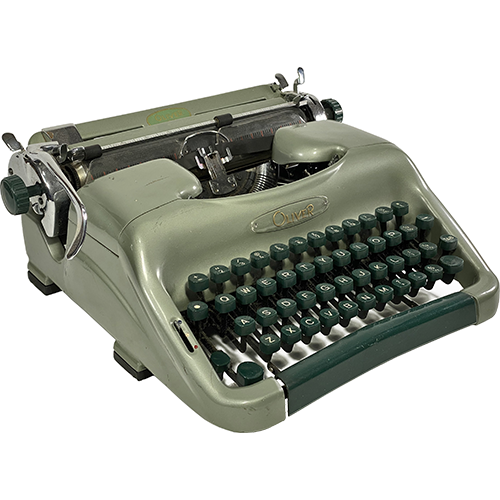 Oliver MT10 (Earlier)
Oliver MT10 (Earlier)
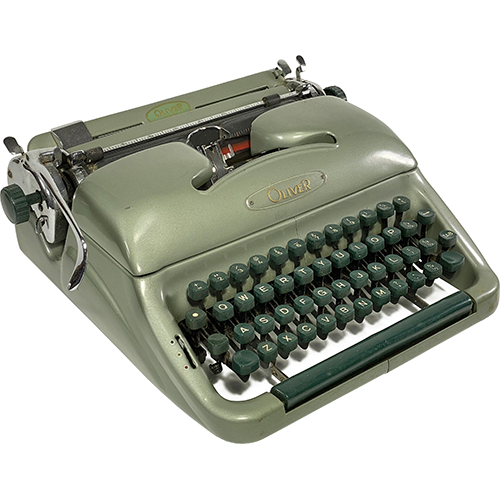 Oliver MT10 (Later)
Oliver MT10 (Later)
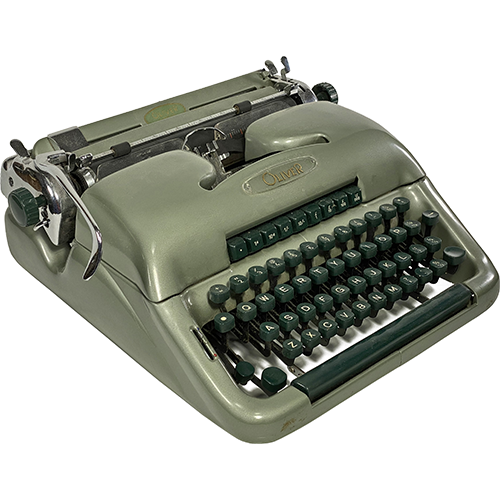 Oliver MDT10 (Later)
The Oliver Consort, manufactured by Voss Schreibmaschinenfabrik GmbH in Wuppertal, Western Germany, forms a family of rebranded Voss machines of two distinct body styles. Both body styles were marketed under the name Oliver Consort, but branded as MT 10, MDT 10, MT 13, or MDT 13, depending on tabulator and carriage combination.
Oliver MDT10 (Later)
The Oliver Consort, manufactured by Voss Schreibmaschinenfabrik GmbH in Wuppertal, Western Germany, forms a family of rebranded Voss machines of two distinct body styles. Both body styles were marketed under the name Oliver Consort, but branded as MT 10, MDT 10, MT 13, or MDT 13, depending on tabulator and carriage combination.











































































